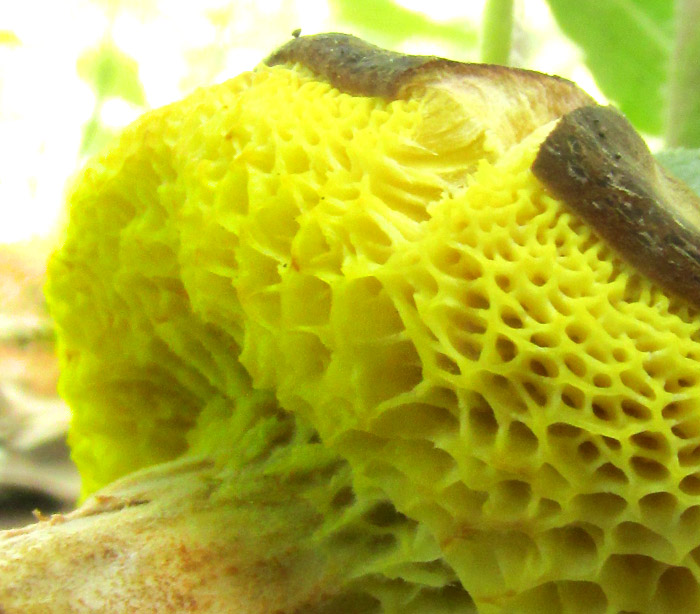Excerpts from Jim Conrad's
Naturalist Newsletter
Entry from field notes dated September 1, 2023, taken in Los Mármoles National Park in the Eastern Sierra Madre mountains, Hidalgo state, MÉXICO, along steeply climbing road heading eastward out of town of Trancas {on maps designated "Morelos (Trancas)"} toward Nicolás Flores; juniper/pine forest on limestone bedrock; elevation ~2,300m (~7,550ft); ~N20.80°, ~W99.25°
SUEDE BOLETE

On a forested ridge sometimes grazed by roaming cattle, near the trunk of the oak tree Quercus laurina, the above mushroom was one of three growing within a few feet of one another. I thought the splitting cap may have resulted from the severe, continuing drought the area has undergone for nearly two years but, later when I knew its name and could look it up, many pictures of the species showed similarly cracked caps; also one common name for the species was Yellow-cracked Bolete.

The above picture shows another mushroom of the same species for some reason bent over, its stalk, or stipe, looking damaged. Notice the sudsy looking cluster of bubbles in the shade beneath the cap. They could be snail eggs, and I wondered if the stalk might have been snail-eaten.

Clearly this isn't a gilled mushroom, but rather the kind whose spores fall from pores on the cap's underside. In general, when you see a fair-sized mushroom growing on the ground with pores instead of gills, and a thickish stem, a good first thought is that probably you have a "bolete." Many but not all boletes make fine eating. Boletes are members of the Boletus Family, the Boletaceae, and "classic boletes" are members of the big genus Boletus, occurring nearly worldwide.
However, the Boletus Family embraces several genera, so here do we have a real Boletus? The Boletus mushrooms I've encountered were very similar to our cracked mushrooms, but their pores were smaller and more consistently of the same size. Also, they lacked this mushroom's very large, irregularly shaped pores occurring near the stem, and I didn't recall that on any of them their yellow, pore-developing tissue, the hymenium, briefly extended down the stipe.
We don't have any kind of published literature even halfway comprehensively helping us identify Mexican mushrooms in the field, so I identify them by making Internet image searches using appropriate keywords. In this case, I searched on the Spanish words "boletus amarilla mexico" (boletus yellow mexico). On the resulting page of thumbnail images, nothing looked exactly right, but the most similar images were identified as members of the genus Xerocomus, so a search for images of Xerocomus species was made. Pictures looking just like our mushroom turned up labeled XEROCOMUS SUBTOMENTOSUS. Though English speakers do sometimes call this species Yellow-cracked Bolete, more commonly it's referred to as the Suede Bolete.
The name Xerocomus subtomentosus was bestowed by Linnaeus himself back in 1753. Mostly the species is distributed in Europe and North America, but it pops up here and there elsewhere, as in Mexico, where it follows the higher elevations southward, apparently into northwestern South America.
However, it's suspected that the name Xerocomus subtomentosus is being applied to several, possibly many, look-alike species. As Michael Kuo of MushroomExpert.Com writes, "The 'true' Xerocomus subtomentosus must come from Sweden, by virtue of the fact that Linnaeus first described it from there." But are North American ones, and our Mexican ones, and those of Japan and southeastern Australia, all the same species? Xerocomus subtomentosus enters into a mycorrhizal relationship with various tree species, but none of our trees also occurs in Sweden. We'll just have to wait for more studies before knowing if our Mexican Xerocomus subtomentosus mushrooms really are Xerocomus subtomentosus.
Another hint that we may have something different here is that often Boletus mushrooms quickly develop a dark bruise if the cap is poked with a finger, and most descriptions of Xerocomus subtomentosus describe it as often bruising bluish. Ours didn't.
Our mushroom is described as edible, but not flavorful. It's advised to mix it with others which taste better.
The 2005 study by Anna A. Grodzinskaya and others entitled "Radioactive Contamination of Ukrainian Mushrooms," published 18 years after the Chernobyl catastrophe, documents the accumulation of radioactive isotopes in mushrooms growing in the Chernobyl area. The article says that under Ukrainian law, for mushrooms to be eaten, the maximum permitted level of Cesium-137, or 137Cs, is 2500 Bq/kg d.w. The 137Cs level detected in Xerocomus subtomentosus mushrooms picked in the vicinity of the Chernobyl Power Plant in 2004 was 20,000,000 Bq/kg d.w. Those mushrooms contained 8000 times more radioactive 137Cs than permitted by law. Unfortunately, the study team found that collecting of mushrooms in Chernobyl's "Exclusion Zone" was "practically not controlled."
The team also tried to determine whether the mushrooms were mutating by measuring spore dimensions. They found that spores of Xerocomus subtomentosus were longer than normal, but in the end couldn't be certain that this was not just a local geographically based natural expression.